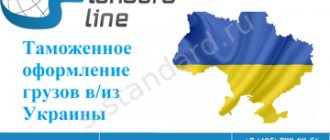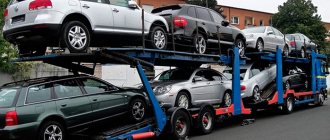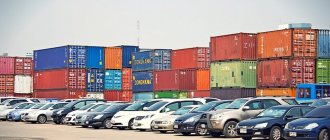Problems of passing customs inspection and official registration of a vehicle when exporting a car or truck from a neighboring country are not always quick and problem-free. Let's look at this using the example of customs clearance of cars in Kazakhstan in 2021.
This state, along with the Republic of Belarus, Armenia, Kyrgyzstan and Russia, are members of the Customs Union.
It should be noted right away that in 2019 , a vehicle imported from the territory of the EAEU member countries must comply with Euro 5 standards, be equipped with airbags, have an ISOFIX mount and an ABS system. Its owner, already on the territory of the Republic of Kazakhstan, will have to install an EVAC button, pay fees for initial registration and disposal.
Customs clearance of cars from Russia in Kazakhstan
The taxes payable on customs clearance of electric vehicles are slightly different from the taxes payable on petrol and diesel cars.
From May 4, 2021 until the end of 2021, zero duties were introduced on the import of electric vehicles.
So, when clearing electric vehicles through customs, you must pay the following taxes:
- Customs clearance fee . The fee amounts are shown below.
- Customs duty
- Recycling collection . For all cars, including cars with electric motors, it is calculated at uniform rates. The calculation of the recycling fee is described below.
- VAT . Legal entities and individuals pay. VAT is 20% of the amount: catalog value of the car + customs duty + excise tax.
- Excise tax . Both individuals and legal entities pay. Excise tax rates are given below.
The amount of the fee depends only on the cost of the car.
The new customs duty rates are effective from August 1, 2020.
| Cost of the car, rub. | Cost of registration, rub. |
| up to 200,000 | 775 |
| up to 450,000 | 1 550 |
| up to 1,200,000 | 3 100 |
| up to 2,700,000 | 8 530 |
| up to 4,200,000 | 12 000 |
| up to 5,500,000 | 15 500 |
| up to 7,000,000 | 20 000 |
| up to 8,000,000 | 23 000 |
| up to 9,000,000 | 25 000 |
| up to 10,000,000 | 27 000 |
| over 10,000,000 | 30 000 |
The recycling fee is calculated using the following formula:
BC = BS × K BS – base rate K – coefficient.
The base rate is determined by the category of the vehicle:
- passenger cars for non-commercial use - RUB 20,000.
- commercial vehicles (both cars and trucks and buses) - RUB 150,000.
Coefficient values for individuals:
| For cars under 3 years old | For cars older than 3 years |
| 0.17 | 0.26 |
Coefficient values for legal entities:
| Engine capacity | up to 1000 cm3 | 1001 – 2000 cm3 | 2001 – 3000 cm3 | 3001 – 3500 cm3 | over 3500 cm3 | electric cars |
| Cars under 3 years old | 2.41 | 8.92 | 14.08 | 12.98 | 22.25 | 1.63 |
| Cars older than 3 years | 6.15 | 15.69 | 24.01 | 28.5 | 35.01 | 6.1 |
The amount of excise tax on cars depends on the engine power.
The new rates are effective from January 1, 2021.
Current excise tax rates:
| Engine power | Excise tax rate |
| up to 90 hp | 0 rub. for 1 hp |
| 91 – 150 hp | 51 rub. for 1 hp |
| 151 – 200 hp | 491 rub. for 1 hp |
| 201 – 300 hp | 804 rub. for 1 hp |
| 301 – 400 hp | 1370 rub. for 1 hp |
| 401 – 500 hp | 1418 rub. for 1 hp |
| over 501 hp | 1464 rub. for 1 hp |
Evasion from customs clearance
In case of deliberate evasion of customs clearance of a foreign car, the laws of the Russian Federation Code of Administrative Offenses Ch. 16 and Criminal Code Art. 194 provide for the following penalties for violators:
- With administrative responsibility. There are 3 possible punishment options: 3 times the cost of the car, confiscation of the car or a fine of 2.5 thousand rubles if invalid documents for the vehicle are provided.
- In case of criminal liability and evasion of customs duties up to 1 million rubles. A fine of 100 thousand rubles, forced labor or imprisonment for a period of 2 years.
- If criminal liability arose due to evasion of customs duties in the amount of 3 million rubles, one of three penalties is applied to the offender. Fine from 300 thousand rubles, forced labor or imprisonment for a period of 5 years.
Revealing the fact of an offense for the import of foreign cars into Russia on the part of a motorist will necessarily entail administrative or criminal liability.
Which is cheaper: clearing a car through customs or buying the same one in Kazakhstan?
The following are subject to customs declaration in writing:
- cash and (or) traveler's checks, if the total amount of such cash and (or) traveler's checks during their one-time import into the customs territory of the EAEU or one-time export from the customs territory of the Union exceeds an amount equivalent to 10 thousand US dollars at the exchange rate, valid on the day of submission of the passenger customs declaration to the customs authority;
- monetary instruments, with the exception of traveler's checks.
If the total amount of transferred cash and (or) traveler's checks is equal to or does not exceed the equivalent of 10 thousand US dollars, an individual can declare such cash and (or) traveler's checks at his own request .
Monetary instruments are traveler's checks, bills of exchange, checks (bank checks), as well as securities in documentary form, which certify the obligation of the issuer (debtor) to pay funds and which do not indicate the person to whom such payment is made.
When declaring cash and (or) monetary instruments by individuals, a passenger customs declaration is used, in which, among other things, the additional form “Declaration of cash and (or) monetary instruments” must be filled out.
When customs declaring monetary instruments, with the exception of traveler's checks, the passenger customs declaration shall indicate the nominal value or the corresponding amount in the currency of the Member State or foreign currency, the right to receive which is certified by the monetary instrument.
If the nominal value is missing and it is impossible to determine the amount in the passenger customs declaration, the number of transferred monetary instruments is indicated.
In cases where the total amount of cash and (or) monetary instruments when imported into the customs territory of the EAEU exceeds an amount equivalent to 100 thousand US dollars, the passenger customs declaration is accompanied by the submission of documents to confirm the origin of cash and (or) monetary instruments.
Documents confirming the origin of cash and monetary instruments may include:
- A certificate of the right to inheritance or another document issued by an authorized body, including a foreign state, indicating the inheritance of cash and monetary instruments;
- A notarized agreement, the subject of which is the transferred funds and monetary instruments;
- A certificate issued by a bank or non-bank financial institution regarding the withdrawal of cash from the account;
- A notarized contract for the sale and purchase of movable and immovable property (payment for which is made in cash);
- A cash receipt (other document) issued by the organizer of a lottery, competition, sports or cultural event, gambling establishment, etc., confirming the payment of winnings (prize) to an individual;
Other documents, including notarized ones, issued by the owner (holder) of funds, containing details of the body (organization) and confirming the origin of cash and monetary instruments.
International postal items - parcels and items of written correspondence that are objects of postal exchange in accordance with the acts of the Universal Postal Union (UPU), are accompanied by documents, are sent outside the customs territory of the EAEU from places (institutions) of international postal exchange, or enter the customs territory of the EAEU to places (institutions) of international postal exchange, or in transit through the customs territory of the EAEU.
Without paying customs duties, citizens of Kazakhstan can receive goods in parcels for personal use worth no more than 200 euros and weighing no more than 31 kg.
If the established standards are exceeded, customs duties will be required at a rate of 15% of the cost, but not less than 2 euros per kilogram of weight in terms of excess of cost and/or weight standards.
For example, if you order a smartphone on AliExpress for 1,000 euros, then you will have to pay 120 euros (1000-200)X15%) for customs clearance.
When importing goods weighing more than 31 kg, you will have to pay 2 euros for each extra kg. That is, if the excess weight of the goods is 10 kg, then the duty amount will be 20 euros.
If the goods simultaneously weigh more than 31 kg and exceed the cost of more than 200 euros, then a duty will be collected in one of two categories, the most beneficial to the state.
In case of import of goods for personal use, the cost, weight and (or) quantity of which exceed the norms for duty-free import, as well as vehicles, customs duties and taxes are subject to payment at uniform rates or in the form of a cumulative customs payment.
The cost of goods for personal use does not include the costs of their transportation and insurance.
For international postal items stored in places (institutions) of international postal exchange, the temporary storage period is 6 months.
The organization providing postal services on the territory of the Republic of Kazakhstan is the Kazpost Joint Stock Company. You can track your parcel on the official website of Kazpost JSC www.post.kz (tracked from the moment the parcel crosses the border of the Republic of Kazakhstan).
Dear user!
Make sure NCALayer is running/installed and try again.
Instructions for starting the program
To further work with egov.kz, you need to install a certificate from the National Certification Authority of the Republic of Kazakhstan.
Dear user!
Make sure NCALayer is running/installed and try again.
Instructions for starting the program
The amount of initial registration depends not only on the size of the monthly calculation index, but also on the age of the car. Payment for the service is made at the cash desk of the Specialized Public Service Center. Initial registration of new cars is cheap, but older cars are more expensive:
- up to two years (years of manufacture 2018-2019) – 0.25 MCI (662 tenge);
- from two to three years (2017-2018 production) – 50 MCI (132,550 tenge);
- older than three years (year of manufacture 2016 and earlier) – 500 MCI (1,325,500 tenge).
The fee for producing a technical passport will cost 1.25 MCI (3,313 tenge). Two duplicates of a regular license plate cost 2.8 MCI (7,422 tenge).
To register a car imported from abroad in Kazakhstan, you need to contact the Specialized Public Service Center at your place of residence. To register you will have to:
- pay a recycling fee;
- pay customs duties;
- pay value added tax;
- obtain a vehicle design safety certificate (SBCTS) and an EVAC safety system.
A recycling fee is a payment for the harmful effects of a car on the environment and human health, taking into account its technical characteristics. It can be paid online on the website of Operator of Extended Producer Obligations (EPO) LLP.
The amount depends on the engine size. The formula is: 50 MCI multiplied by the engine displacement coefficient:
- Cars with an engine capacity of up to 1,000 cm3 – 50 MCI (132,550) x 3 (coefficient) = 397,650 tenge.
- Cars with an engine capacity of up to 2,000 cm3 – 50 MCI (132,550) x 7 (coefficient) = 927,850 tenge.
- Cars with an engine capacity of up to 3,000 cm3 – 50 MCI (132,550) x 10 (coefficient) = 1,325,500 tenge.
- Cars with an engine capacity over 3,001 cm3 – 50 MCI (132,550) x 23 (coefficient) = 3,048,650 tenge.
The customs duty is 17% of the cost of the car. The cost is indicated in the declaration by the car owners themselves. You must include a receipt and a sales contract as proof. If there is no receipt, and the price indicated in the declaration is lower than the market price, customs officers make an assessment themselves.
But owners of cars purchased in Armenia and Kyrgyzstan will not have to pay 17% of the cost of the car. Since when importing a car into the EAEU country (Armenia, Kyrgyzstan), a customs duty of 10% of the cost of the car has already been paid, the owners will have to pay the difference between the paid duty and the Kazakh duty.
Example. When importing a car to Armenia, its customs value was 5 million tenge. Until January 1, 2021, a duty of 10% was in force in Armenia - 500,000 tenge. Let’s say this car has now reached Kazakhstan. To clear it through customs, you need to pay the difference (17% of 5 million tenge = 850,000 tenge, and the difference between customs payments: 850,000 – 500,000 = 350,000 tenge). If the customs value of the car has not changed during this time, you will need to pay 350 thousand tenge.
If all of the above options cost a pretty penny, then there are two more options, but both are unprofitable:
- Sell your car for parts.
- Sell the car in the country of purchase.
Selling a car for parts will not cover the cost of buying a car. Second option too. The fact is that starting this year, identical technical requirements for cars are in force in Armenia. That is, transport below the Euro-4 standard, and also not equipped with the necessary technical means, has lost in price.
It will not be possible to scrap a car, because they only accept cars that have permanent registration in Kazakhstan.
Customs clearance in everyday life is the procedure for customs clearance of any things crossing the border of a particular state. A similar procedure applies to vehicles imported into the country for permanent use.
The essence of customs clearance can be reduced to three actions:
- A car crosses the Russian border;
- The person transporting the car provides the necessary documents to the customs authorities and pays the required fee;
- Customs officers accept these documents, check payment of the fee, inspect the car crossing the border and make a decision on the permissibility of importing the car.
The main objective of such a procedure is to legalize the imported item on the territory of Russia, protect the economic interests of the state, as well as replenish the budget - after all, customs duties are collected for each imported product. In addition, customs clearance contributes to the control of cars in Russia.
To carry out the procedure, you must provide a certain set of documents to customs:
- Internal and foreign passports of the person importing the car.
- Technical passport of the car.
- Certificate of compliance of the vehicle with environmental standards in force in Russia.
- An application in which the car owner requests to carry out customs clearance of the car and return to him the funds contributed as customs security.
- A receipt stating that the car owner has deposited security funds into the customs deposit account.
- Notification of the vehicle's arrival at the customs temporary storage warehouse.
- An expert opinion indicating the technical characteristics of the car.
- Customs declaration form TD-6.
- Vehicle registration card with attached declaration in form TD-7.
- Documents confirming the purchase of the car. Most often this is a purchase and sale agreement.
- Documents confirming that the car is insured under the MTPL contract.
How to clear customs a motorcycle from Europe (Poland, Belarus, Lithuania, Germany)
If your choice of motorcycle is the German BMW R1200RT, it makes sense to pay attention to used models from Europe, since the price from an official dealer may be too high. The state duty for importing equipment from Europe can range from 40%. The customs value will be calculated according to the Eurotax catalog “SCHWACKE” (popularly “Schwacke”). Please note that the Shvaka price may be higher than what you paid for the bike. Therefore, in Europe it makes sense to order, for example, what you will not find in Japan. So it’s better to look for a 125 cc Yamaha or 600 cc road Honda in the Land of the Rising Sun.
How much does it cost to clear customs and register a car in Kazakhstan?
Those who decide to buy a car abroad are, of course, concerned about the cost of the customs clearance procedure.
The price is influenced by the following factors:
- Age of the vehicle.
- Price.
- Engine capacity.
If you buy a car whose age does not exceed three years, the cost of its customs clearance will be calculated according to the following table:
| Car price | Coefficient No. 1 | Coefficient No. 2 |
| up to 8,500 euros | 54% | 2.5 euros for each cubic centimeter of engine volume |
| from 8,500 to 16,700 euros | 48% | 3.5 euros for each cubic centimeter of engine volume |
| From 16,700 to 42,300 euros | 48% | 5.5 euros for each cubic centimeter of engine volume |
| From 42,300 to 84,500 euros | 48% | 7.5 euros for each cubic centimeter of engine volume |
| From 84,500 to 169,000 euros | 48% | 15 euros for each cubic centimeter of engine volume |
| From 169,000 euros and above | 48% | 20 euros for each cubic centimeter of engine volume |
When calculating this state duty, from the two calculation coefficients indicated in the second and third columns, the largest one is selected, which is subject to payment.
To carry out the customs clearance procedure, the motorist must take the following actions:
- Selecting a vehicle. At this stage, you need to determine the brand of car you want to buy, choose a seller, and also calculate the cost of customs clearance based on the characteristics of the car.
- Determining the delivery method. You need to decide how the car will get to the border. You can order its delivery from a specialized transport company, but it will be much cheaper to carry it out yourself.
After the first two steps, you need to make a general calculation of expenses. Based on its results, it often turns out that buying a car abroad is unprofitable and it will be much cheaper to buy it in Russia. If the purchase is still cheaper than at home, we proceed to the following steps:
- Depositing the security deposit with the customs office. In order to ensure customs clearance, it is necessary to deposit the approximate cost of the car into the customs account. This must be done in advance, since the money may take several days to reach your bank account from the moment of payment. If you transfer them too late, then at the time the car crosses the border, the amount may not be deposited with the customs authority.
- Buying a car and importing it to Russia.
- Filling out the necessary documents.
- Car insurance. At the moment when the car crosses the border, it must be insured under MTPL.
- Acceptance of the vehicle and title at the customs office. If customs clearance was successful, you need to pick up the car and the technical equipment passport at the specified time.
There are some tricks that will allow you to save on customs clearance. So, if you live near the border of the country from which you imported the car, upon import you can inform that the car is passing through Russian territory in transit. In this case, you will have to cross the border in this car at least once a month.
You can also enter a car without an engine. Then you will not have to carry out customs clearance according to the rules provided for a full-fledged car. The engine can be imported separately or purchased in our country.
Legal entities always pay excise tax.
Individuals pay excise duty only when clearing electric vehicles older than 3 years through customs.
The amount of excise tax on cars depends on the engine power. Rates are valid from January 1, 2021.
Current excise tax rates: Engine power Excise tax rate up to 90 hp. 0 rub. for 1 hp 91 - 150 hp
45 rub. for 1 hp 150 - 200 hp
437 rub. for 1 hp 200 - 300 hp 714 rub. for 1 hp 300 - 400 hp
1218 rub. for 1 hp 400 - 500 hp 1260 rub. for 1 hp over 500 hp 1302 rub. for 1 hp
Buying a car from an official dealer
Some Russians buy cars at official dealerships. At the same time, they choose from those models that are presented in the showroom, or place an order for a specific configuration. The domestic auto industry, represented by AvtoVAZ and several foreign assembly plants, has shown constant growth rates over the past 20 years.
Car brands Lada, UAZ, GAZ and KamAZ are produced in Russia in a full cycle. And some foreign companies assemble cars from ready-made vehicle kits on the territory of the Russian Federation.
| Location | Brands | Car brands or models |
| St. Petersburg | Hyundai, Nissan, Toyota General Motors | Nissan Qashqai, Nissan X-Trail, Nissan Murano, Toyota Camry, Toyota RAV4, Hyundai Solaris, Hyundai Creta, Kia Rio and Kia Rio X-Line |
| Vsevolzhsk | Ford-Vsevolzhsk | Focus, Mondeo |
| Kaliningrad | Avtotor | Kia, Hyundai, BMW |
| Kaluga | Volkswagen | Volkswagen, Skoda |
| Kaluga region | Group PSA+Mitsubishu | Peugeot, Citroen, Opel, Mitsubishu, Audi |
| Tatarstan | Sollers-Elabuga | Ford Transit |
| Moscow | Renault-Russia Mercedes | Duster, Kaptur, Terrano Mercedes Benz |
| Vladivostok | Mazda+Sollers | CX-5, Mazda6 |
| Cherkessk | Derways | Lifan, Geely, Great Wall and Chery |
Such a wide choice when purchasing a domestically assembled foreign car makes it possible to restrain the rise in prices for goods even with a decrease in the purchasing power of the Russian ruble. This happens because most of the costs of factories are taken into account based on the exchange rate of the national currency of the Russian Federation, and low duties of 0.5-1% are established on imported parts and components. While when importing a finished car, you will need to pay from 15 to 50% of the original cost.
Foreign cars imported into the Russian Federation are now most often budget or premium class cars. Also, complex foreign models that require special skills or special expensive equipment are not assembled at Russian factories.
Asian models occupy a large share of imported cars on the Russian market. The most budget option is the Uzbek Ravon from General Motors. It is noteworthy that in Uzbekistan itself it costs residents more than it costs Russians. Such a high price within the country is due to currency fluctuations and high excise taxes on cars.
New customs clearance of cars in Kazakhstan: exact amounts announced
Our journalists are not afraid to get the truth and show it to you. In a country where the authorities constantly want to ban something, including banning telling the truth, there must be publications that continue to engage in real journalism.
We want to depend only on you - those who want to know the truth, those who are not afraid to be free. Help us tell you the truth.
Please support us with your contribution to independent journalism!
January 2020
| Mon | W | Wed | Thu | Fri | Sat | Sun |
| 1 | 2 | 3 | 4 | 5 | ||
| 6 | 7 | 8 | 9 | 10 | 11 | 12 |
| 13 | 14 | 15 | 16 | 17 | 18 | 19 |
| 20 | 21 | 22 | 23 | 24 | 25 | 26 |
| 27 | 28 | 29 | 30 | 31 | ||
A car imported from abroad of the Russian Federation must be placed in the customs control zone - temporary storage warehouse. Temporary storage warehouse is a temporary storage warehouse for a car. It is located on the territory of the customs office at your place of residence.
How the technical equipment is registered at the temporary storage warehouse:
- The owner draws up a package consisting of basic certificates, certificates and supporting documents. When going through the procedure, all documents issued by customs must be kept and provided.
- The applicant must contact the declarant. The owner brings the car and provides documents.
- The arrival of the car is controlled by a warehouse employee.
- The specialist checks the documents and delivery times.
- The warehouse representative carries out the identification contract. The body, engine numbers, transit numbers, etc. are subject to mandatory inspection. After the procedure, a customs inspection report is drawn up.
- A notification of the arrival of the vehicle and an acceptance certificate at the warehouse are issued.
- The driver turns to the declarant with the forms.
- The employee prepares the passenger declaration. Copies are stamped and personally signed. The owner who applies to the temporary storage warehouse is issued one sheet of declaration.
- The beneficiary checks the paid deposit. If the money is deposited, the applicant can claim the funds back. If less cash is deposited, the driver will have to make an additional payment.
- After checking the package of documents, the driver picks up the car.
What is included in the main package of documents for registration at customs at the place of residence?
- application with a request to register a vehicle and transfer money that was previously deposited under a customs receipt against payments;
- transit declaration;
- PTS of a foreign country;
- invoice for new vehicles;
- protocol for supported vehicles;
- identification document;
- TIN, foreign passport;
- notification of arrival at the temporary storage warehouse;
- guarantee of payment of the deposit;
- pledge-guarantee agreement;
- car delivery document;
- certificate of guarantee.
The cost of the procedure depends on the following conditions:
- whether environmental standards are met;
- when the car was imported into the territory of the EAEU;
- the amount of fees for registration in Kazakhstan.
The cheapest option is a small vehicle between three and five years old, purchased by an individual for personal use. For individuals there is a single customs rate. For legal entities – total customs payment.
Vehicles registered in the Republic of Kazakhstan and other countries that are members of the customs union are not subject to additional taxes. You only need to pay funds for paperwork and travel to the place of purchase of the car, as well as transportation to the territory of the Russian Federation.
Comments: 11
Your comment (question) If you have questions about this article, you can tell us. Our team consists of only experienced experts and specialists with specialized education. We will try to help you in this topic:
Author of the article: Klavdiya Treskova
Consultant, author Popovich Anna
Financial author Olga Pikhotskaya
- Elvira
11/18/2021 at 1:53 pm Good afternoon! Please tell me, can I, being a citizen of Moldova, bring my car from Italy to Russia? I have a residence permit in Italy! The period of stay in Russia will be no more than 6 months
Reply ↓ Anna Popovich
20.11.2021 at 14:33Dear Elvira, you can do this.
Reply ↓
11/17/2021 at 11:37 pm
Good evening, I took a risk and bought a foreign car from Abkhazia. But the question is why they are not releasing cars into Russian territory now if I crossed the border in 10 months. I'll wait for the answer
Reply ↓
- Anna Popovich
11/18/2021 at 02:01
Dear Vitaly, there is no such restriction. Operation of vehicles registered in the Republic of Abkhazia is permitted during the period of their temporary import specified in the customs declaration.
Reply ↓
11/17/2021 at 11:36 pm
Good evening, I took a risk and bought a foreign car from Abkhazia. But the question is why they are not releasing cars into Russian territory now if I crossed the border in 10 months.
Reply ↓
11/16/2021 at 01:45
Good afternoon. What are the rules for customs clearance of Abkhaz cars in the DPR?
Reply ↓
- Anna Popovich
11/17/2021 at 00:09
Dear Oksana, you can read the rules at this link.
Reply ↓
04.10.2021 at 16:41
I, a citizen of Abkhazia, received Russian citizenship as a migrant and moved to Russia for permanent residence. I transfer personal property, including cars manufactured in Japan in 2006. Do I qualify for preferential conditions from customs duty exemption?
Reply ↓
- Anna Popovich
06.10.2021 at 02:18
Dear Ainar, duty-free import is possible only for one car and one trailer no later than 18 months from the date of arrival of the specified person for permanent residence in a member state of the Customs Union, provided that the car and trailer were owned by the immigrant for at least 6 months before the date arrival to permanent residence.
Reply ↓
08/11/2021 at 12:49
Hello, my brother bought a car from a company in Abkhazia, but it turned out that he died, what should I do with the car?
Reply ↓
- Anna Popovich
08/12/2021 at 03:23
Dear Greta, ownership will pass to the heir(s).
Reply ↓
Car customs clearance calculator in Kazakhstan 2021
| Position | Bid |
| Passenger vehicles with an active cylinder engines of no more than a thousand cm3 | 15 percent |
| Used from 3 to 5 years | 17 percent |
| From 5 to 7 years | 17 percent |
| More than seven years have passed since their release | 19 percent, but not less than 0.68 euros per 1 cm3 of engine volume |
| With a working volume of more than a thousand cm3, but not more than 1500 cm3 | |
| new | 15 percent |
| Equipped for living | 15 percent |
| Used from 3 to 5 years | 17 percent |
| From 5 to 7 years | 17 percent |
| More than seven years have passed since release | 19 percent, but not less than 0.68 euros per 1 cm3 of engine volume |
From January 1, 2021, the principle of extended obligations of producers (importers) - EPR - has been in effect in Kazakhstan.
EPR obligations apply to products included in the list approved by the authorized body in the field of environmental protection.
The list includes vehicles and automotive components - tires, batteries, oils and fluids.
They plan to accept old agricultural machinery for recycling in Kazakhstan
Thus, car manufacturers, official importers and individuals wishing to import cars into Kazakhstan are required to pay the recycling fee.
Payment of the recycling fee is carried out before the initial registration of the equipment.
The size of the recycling fee is calculated based on the coefficient applied to the basic recycling fee rate for various types of vehicles.
The base rate is 50 monthly calculation indices (MCI). In 2022, the size of 1 MCI is expected to be 3,063 tenge.
Thus, the base rate in 2022 is 153,150 tenge.
Owners of cars with Russian license plates blocked the road in Nur-Sultan
The minimum recycling fee is for cars with electric motors, with the exception of hybrid ones. A coefficient of 3 is applied to them, the size of the disposal fee is 459,450 tenge.
For other passenger cars it is calculated based on engine size:
- up to 1,000 cubic centimeters - coefficient 3 - 459,450 tenge;
- from 1,001 to 2,000 cubic centimeters - coefficient 7 - 1,072,050 tenge;
- from 2,001 to 3,000 cubic centimeters - coefficient 10 - 1,531,500 tenge;
- over 3,001 cubic centimeters - coefficient 23 - 3,522,450 tenge.
For buses with electric motors, except for hybrid ones, the coefficient is 8, the disposal fee is 1,225,200 tenge.
For other passenger buses it is calculated based on engine size:
- up to 2,500 cubic centimeters - coefficient 8 - 1,225,200 tenge;
- from 2,500 to 5,000 cubic centimeters - coefficient 16 - 2,450,400 tenge;
- from 5,000 to 10,000 cubic centimeters - coefficient 21 - 3,216,150 tenge;
- over 10,001 cubic centimeters - coefficient 27 - 4,135,050 tenge.
Calculated based on the rated engine power:
- up to 60 horsepower - coefficient 4 - 612,600 tenge;
- from 61 to 130 horsepower - coefficient 11 - 1,684,650 tenge;
- from 131 to 220 horsepower - coefficient 34 - 5,207,100 tenge;
- from 221 to 380 horsepower - coefficient 58 - 8,882,700 tenge;
- over 380 horsepower - coefficient 80 - 12,252,000 tenge.
The waste collection for grain and forage harvesters is calculated based on the rated engine power:
- up to 160 horsepower - coefficient 18 - 2,756,700 tenge;
- from 161 to 220 horsepower - coefficient 46 - 7,044,900 tenge;
- from 221 to 255 horsepower - coefficient 64 - 9,801,600 tenge;
- from 256 to 400 horsepower - coefficient 76 - 11,639,400 tenge;
- over 400 horsepower - coefficient 90 - 13,783,500 tenge.
- I lost the registration certificate for my car. What to do?
- EPTS in Kazakhstan
- Matching tire and wheel widths
- Customs clearance of cars in Kazakhstan
- Recycling of vehicles in Kazakhstan
- Certification of motor vehicles in the Republic of Kazakhstan
How to clear customs a motorcycle from Japan?
If you have long dreamed of a Kawasaki GTR 1400 or the iconic touring Honda Gold Wing 1800, brought straight from their historical homeland to your home, calculate the cost using the above diagram. The duty in this case can be 18-45% of the cost of the model. In the case of Kawasaki, you will need to include excise tax in your purchase budget (455 rubles multiplied by 160 hp + 20% VAT). For Honda with a power of 117 - 126.5 hp. Depending on the year of manufacture, this is not necessary.
In general, Japan is famous for its large selection of heavy models and low logistics costs compared to equipment from Europe. It is also necessary to include in the budget the cost of storing equipment in a warehouse until the moment when it can be officially imported into the Russian Federation (calculated on a daily basis).
Register a car from the EAEU: who to pay and how much
- Driver's license categories in...
- Check for traffic fines...
- Locations of paid parking…
- Toll roads in Kazakhstan...
- Technical inspection information system in Kazakhstan
- Technical inspection in Kazakhstan
- Car insurance in Kazakhstan...
- Liquid glass for cars
- Exhaust catalyst
- Transport tax in 2021
- Paid parking in Nur-Sultan
- Yandex.Traffic Map
- What to do if you get into an accident
The main difference in the customs clearance procedure between a regular car and special-purpose equipment is higher duties.
The organization importing such machines must have a card of a participant in foreign economic activity of the Republic of Kazakhstan. You can get it in any city in the Republic of Kazakhstan.
Also, the transaction must be carried out only by bank transfer, through a bank.
To legalize equipment from foreign countries, the following is required:
- supplier documents on transportation,
- invoice,
- export declaration,
- certificate confirming the origin of the goods.
A guarantee of support is also issued, confirming that the customs clearance object is safe and sound to the final addressee.
When calculating the customs value, the price of the vehicle and the costs of delivery to the border with Kazakhstan are taken into account and depend on the type of special equipment:
- truck cranes, manipulator cranes and excavators - five percent each,
- crawler tractors - fifteen percent.
But dump trucks, loaders, agricultural tractors, concrete pumps are not subject to duty. There is also a zero rate for all equipment produced in the Russian Federation.
Purchasing and customs clearance of cars from the EAEU: Belarus, Kazakhstan, Armenia and Kyrgyzstan was previously attractive due to its relatively low price. This was due to the fact that the rules of customs clearance in these countries differed from Russian ones. Many Russian car enthusiasts went to these countries to buy a car, and the flow of imported cars was significant. Now the conditions for customs clearance of cars in the EAEU countries have been brought into line with Russian ones. Now, when importing a car into Russia, you will at least need to pay a recycling fee and connect it to the GLONASS system. The purchased car must be deregistered in the seller’s country, after which the registration and receipt of the title takes place at the excise customs of the Russian Federation at the place of registration of the buyer. When importing a car from Armenia or Kyrgyzstan, you will most likely have to pay the difference in underpaid payments, because In these countries, preferential national customs clearance was previously used. This procedure is carried out at the border of entry into the Russian Federation by the individual himself. True, there are exceptions: cars imported into Armenia and Kyrgyzstan at uniform duty rates after 06.2020 are cleared through customs in the Russian Federation without additional customs duties. And in the Republic of Belarus, the year of manufacture of the car, its environmental class and national benefits applied during customs clearance in the Republic of Belarus are not important. To make the purchase profitable, and to make the process of registering a car in the Russian Federation with obtaining an EPTS for subsequent registration with the State Traffic Safety Inspectorate simple, it is better to immediately contact a trusted customs representative who will resolve these issues professionally. Ours is such a customs representative. We will help you quickly and inexpensively import and clear customs cars from the EAEU countries.
What is important for the owner of an Abkhazian foreign car to consider?
A car owner with a foreign car that has been cleared by customs in Abkhazia and entered the territory of the Russian Federation under the temporary import regime can travel when he has:
- driver's license and registration certificate for the car;
- customs declaration, travel and waybills;
- a valid MTPL policy issued in the Russian Federation.
In addition, only those citizens who entered the territory of the Russian Federation from Abkhazia are allowed to drive a foreign car.
This scheme for duty-free import of foreign cars has gained great popularity among Russians. Not only European or American, but also Japanese cars are in demand. Intermediary services for selecting a car and preparing documents cost in the range from 20 to 40 thousand rubles. However, this method of saving comes with a number of disadvantages:
- The buyer does not become the actual owner of the car.
- Periodically you will need to cross the Russian-Abkhaz border.
- Traffic police officers stop foreign cars with foreign license plates much more often than with Russian ones.
- There is a certain risk and the possibility of becoming a participant in an illegal transaction on the part of the seller or intermediary.
- Legislation in the Russian Federation is not static and any amendments may change the conditions for the use of foreign cars with Abkhaz license plates.
Before buying and importing a foreign car through Abkhazia, it is advisable to analyze all the risks and inconveniences associated with such a scheme. But some Russians do not take into account all the disadvantages of the described method, but only pay attention to the savings when buying an expensive premium car.
As experts predict, reducing duties on the import of foreign cars into Russia will not lead to an increase in import volumes, but at the same time the prices for the cars themselves will rise. This is primarily due to the fact that the cost of cars has risen by 60% over the past 5 years, while the dollar has increased by 85%, the yuan by 72% and the yen by 69%. Therefore, most likely, new foreign cars will continue to rise in price. Most of all, prices will depend on fluctuations in the exchange rates of the producing countries.
5 / 5 ( 1 voice )
about the author
Klavdiya Treskova - higher education with qualification “Economist”, with specializations “Economics and Management” and “Computer Technologies” at PSU. She worked in a bank in positions from operator to acting. Head of the Department for servicing private and corporate clients. Every year she successfully passed certifications, education and training in banking services. Total work experience in the bank is more than 15 years. [email protected]
Is this article useful? Not really
Help us find out how much this article helped you. If something is missing or the information is not accurate, please report it below in the comments or write to us by email
How much to pay for scrappage tax on a car in Kazakhstan in 2022
Customs clearance of vehicles is a specialized customs clearance procedure in which a vehicle is placed under customs regime for a certain period. During the technical inspection of the car, the car owner is given a document of conformity, on the basis of which a foreign car can move freely on the roads of the Russian Federation. It is possible to clear a vehicle through customs either independently or with the help of a customs broker.
For foreign cars imported from the CIS countries in 2021, a simplified customs clearance procedure applies if:
Citizens of Kyrgyzstan and Kazakhstan do not need anything to drive their own car in Russia. But the time is limited by the permitted period of stay on Russian territory.
The common economic and customs space created conditions for duty-free circulation of goods between the acceding countries. In 2021, all citizens of the EAEU have the right to import a car into the Russian Federation without customs clearance, not for six months, as was the case for Russians, but for one year. True, as before, subject to providing financial guarantees for payment of customs duties and taxes (making a refundable deposit).
The car markets of Kyrgyzstan and Kazakhstan are attractive to us for the following reasons:
- Many popular models are produced, for example, in Kazakhstan, and you simply cannot find them in Russia.
- The cost of cars there is significantly lower.
The car must be registered in the EAEU country and comply with the environmental requirements of Russian legislation.
Today it is Euro 5. Customs duties there, as already noted, have been lower for a long time. Therefore, it is quite possible to purchase a high-quality and relatively new car at a favorable price.
Changing your place of residence requires full legalization of not only personal documents, but also personal transport. Russia is striving to simplify the solution of this problem as much as possible. Inclusion in the resettlement program completely eliminates taxes, fees and duties for one imported car. Moreover, at the time of crossing the Russian border, the car must have been owned by the family for at least a year.
Documents for customs clearance of vehicles from Kazakhstan:
- driver's identification card;
- PTS for the car;
- accompanying documents for the vehicle, such as: environmental passport of the car, which indicates the safety class;
- car insurance.
First of all, the future owner of the vehicle must pay customs duty. It is worth considering that used vehicles are subject to a single rate.
When customs clearance is not needed
Due to the high cost of customs clearance of an imported car, some buyers are looking for options where they can avoid paying duties and still use the car. Foreign citizens or Russians who have a permanent residence permit outside the country can apply for temporary importation. But such an operation is not available to all citizens. The buyer must have either foreign citizenship or a residence permit in another state. And even in this case, you will have to follow a certain procedure, otherwise the motorist will face fines.
Temporary import of foreign cars into Russia can be issued for passenger cars for personal use with up to 12 seats. It is prohibited to engage in commercial activities in such cars, for example, private transportation. The owner of several cars can obtain temporary import for only one vehicle.
Foreigners register their own cars under the temporary import regime for one calendar year without paying any customs duties. Moreover, if the car owner plans to stay in the Russian Federation for more than 6 months, then he will need to register the car temporarily with the traffic police.
Some Russians brought 5-10 foreign cars from abroad and registered them under the temporary duty-free import regime. To fill the gap, an amendment was made to the legislation so that one owner can register only one car for temporary import.
The second protective measure to prevent abuse of the temporary import regime is a deposit. If customs officers suspect that the car will be imported by a foreigner or a citizen of the Russian Federation for subsequent resale, which is illegal, then he will be required to pay a security amount (deposit). The amount of the contribution is equal to the total volume of customs duties and fees. It becomes a guarantee that the car owner will comply with Russian legislation and will remove his own vehicle within the specified period or carry out the customs clearance procedure.
If the car leaves the country before a certain date, the deposit amount will be returned to the citizen. If the car owner decides to carry out customs clearance and the amount of payments turns out to be less than the deposit, then upon application the difference will be returned to him.










